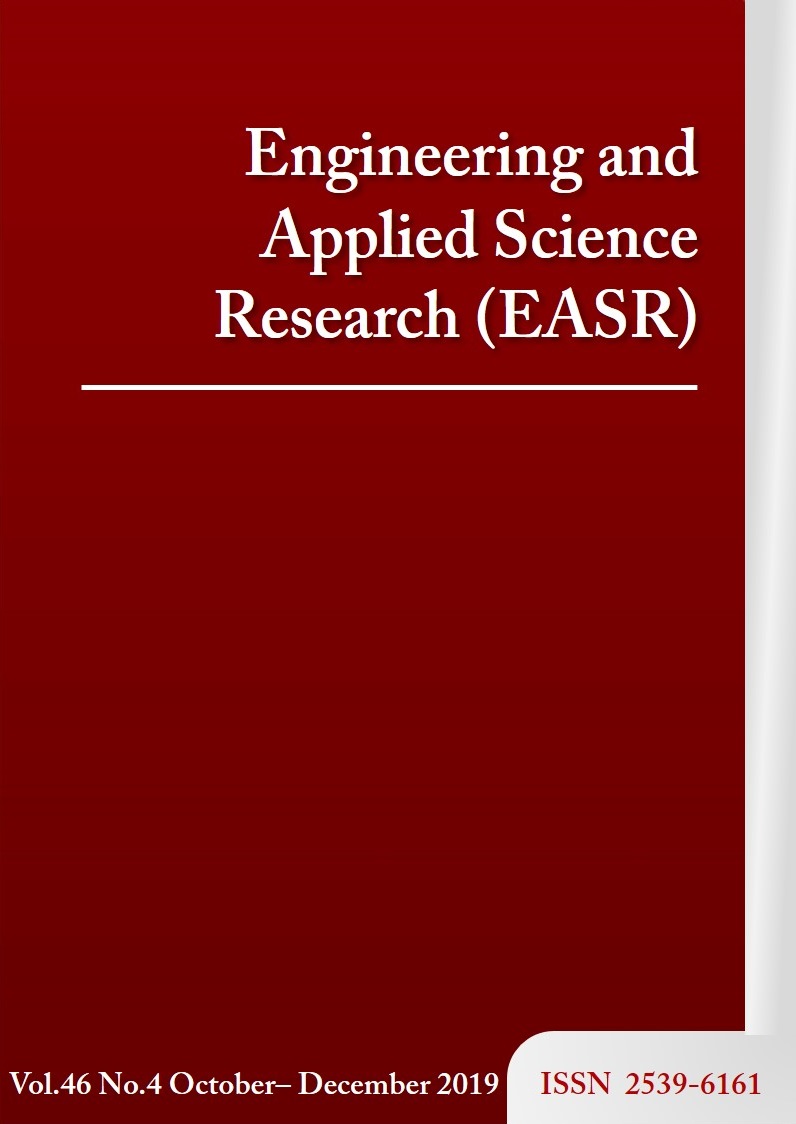Convective systems observed by ground-based radar during the seasonal march of Asian summer monsoons in the middle of Thailand
Main Article Content
Abstract
Understanding the characteristics of clouds is essential to support disaster mitigation and improvement of cultivation planning. Convective systems (CS) are a major contributor to the total number of rain systems over the tropics. In this study, the spatio-temporal characteristics of CSs extracted from instantaneous ground-based radar observations in Phetchabun, in central Thailand, were investigated during the seasonal march of Asian summer monsoons from July to September of 2010. The Open Source Library for Weather Radar Data Processing (Wradlib) was used to create gridded radar reflectivity at instantaneously observed times at a constant altitude of 3 km above the mean sea surface level. The geometric properties of the largest CS, such as echo size, fitted ellipse, and centroid, were also extracted and analyzed by applying the OpenCV library in a Python environment. CS classification produces two classes of CSs based on their speed, stationary and propagating. Propagating CSs are most frequent in August, accounting for 20% of the total number. Additionally, the propagating CSs in August cover relatively larger areas and produce stronger radar echoes than others, while stationary CSs in August have relatively more elongated forms. Classifying CSs based on direction, previous instantaneous scans show that the westerly class dominates across the study area, especially in August. Moreover, the westerly class is associated with stronger radar echoes compared to the easterly class. Additionally, the average speed of the easterly class has a tendency to decrease toward the end of the rainy season. The hot spot area with regard to CS severity has been identified as being in the southwest part of the study area.
Article Details
This work is licensed under a Creative Commons Attribution-NonCommercial-NoDerivatives 4.0 International License.
References
[2] Nesbitt SW, Cifelli R, Rutledge SA. Storm morphology and rainfall characteristics of TRMM precipitation features. Mon Wea Rev. 2006;134:2702-21.
[3] Laing AG, Fritsch JM. The large-scale environments of the global populations of mesoscale convective complexes. Mon Wea Rev. 2000;128:2756-76.
[4] Coniglio MC, Stensrud DJ, Wicker LJ. Effects of upper-level shear on the structure and maintenance of strong quasi-linear mesoscale convective systems. J Atmos Sci. 2006;63:1231-52.
[5] Lang TJ, David AA, Nesbitt SW. Carbone RE. Radar-observed characteristics of precipitating systems during NAME 2004. J Climate. 2007;20:1713-33.
[6] Liu C, Zipser E. Regional variation of morphology of organized convection in the tropics and subtropics. J Geophys Res Atmos, 2013;118:453-66.
[7] Romatschke U, Houze RA. Characteristics of Precipitating Convective Systems in the South Asian Monsoon. J Hydrometeorology. 2011;12:3-26.
[8] Morwal SB, Narkhedkar SG, Padmakumari B, Maheskumar RS, Kulkarni JR. Characteristics of precipitating monsoon clouds over rain-shadow and drought-hit regions of India using radar. Clim Dynam. 2017;9:1-24.
[9] Steiner M, Houze RA, Yuter SE. Climatological characterization of three-dimensional storm structure from operational radar and rain gauge data. J Appl Meteorol. 1995;34:1978-2007.
[10] Xie SP, Xu H, Saji N, Wang Y. Role of narrow mountains in large-scale organization of Asian monsoon convection. J Climate. 2006;19:3420-9.
[11] Matsumoto J. Seasonal transition of summer rainy season over Indochina and adjacent monsoon region. Adv Atmos Sci. 1997;14:231-45.
[12] Ohsawa T, Ueda H, Hayashi T, Watanabe A, Matsumoto J. Diurnal varia-tions of convectivity and rainfall in tropical Asia. J Meteor Soc Japan. 2001;79:333-52.
[13] Wang B, Ho L. Rainy season of the asian–Pacific summer monsoon. J Climate. 2002;15:386-97.
[14] Takahashi HG, Fujinami H, Yasunari T, Matsumoto J. Diurnal rainfall pattern observed by Tropical Rainfall Measuring Mission Precipitation Radar (TRMM–PR) around the Indochina peninsula. J Geophys Res. 2010;115:1-10.
[15] Satomura T. Diurnal variation of precipitation over the Indo-China Peninsula: two-dimensional numerical simulation. J Meteor Soc Japan. 2000;78:461-75.
[16] Okumura K, Satomura T, Oki T, Khantiyanan W. Diurnal variation of precipitation by moving mesoscale systems: radar observations in northern Thailand. Geophys Res Lett. 2003;30(20):1-5.
[17] Heistermann M, Jacobi S, Pfaff T. Technical note: an open source library for processing weather radar data (wradlib). Hydrol Earth Syst Sci. 2013;17:863-71.
[18] Rigo T, Llasat MC. A methodology for the classification of convective structures using meteorological radar: Application to heavy rainfall events on the Mediterranean coast of the Iberian Peninsula. Nat Hazards Earth Syst Sci. 2004;4:59-68.
[19] Rigo T, Llasat MC. Analysis of mesoscale convective systems in Catalonia using meteorological radar for the period 1996–2000. Atmos Res. 2007;83:458-72.
[20] OpenCV [Internet]. Introduction to OpenCV-Python Tutorials [cited 2019 Jun 23]. Available from https://docs.opencv.org/trunk/d0/de3/tutorial_py_intro.html
[21] Getis A, Ord JK. The Analysis of Spatial Association by Use of Distance Statistics. Geogr Anal. 1992;24(3):189-206.
[22] Satomura T, Yamamoto K, Sysouphanthavong B, Phonevilay S. Diurnal variation of radar echo area in the middle of Indochina. J Meteor Soc Japan. 2011;89A:299-305.
[23] Robinson FJ, Sherwood SC, Gerstle D, Liu C, Kirshbaum DJ. Exploring the land-ocean contrast in convective vigor using Islands. J Atmos Sci 2011;68:602-18.
[24] Takahashi H, Yasunari T. A climatological monsoon break in rainfall over Indochina—A singularity in the seasonal march of the Asian summer monsoon. J Climate. 2006;19:1545-56.
[25] Parker MD, Johnson RH. Simulated convective lines with leading precipitation. part II: evolution and maintenance. J Atmos Sci. 2004;61:1656-73.
[26] Fritsch JM, Murphy RJ, Kain JS. Warm core vortex amplification over land. J Atmos Sci. 1994;51:1781-806.
[27] Johnson RH. Diurnal cycle of monsoon convection. The global monsoon system: research and forecast. Singapore: World Scientific Publishing; 2011.
[28] Houze RA. Cloud Dynamics, 2nd ed. Oxford: Academic Press; 2014.
[29] Carbone RE, Tuttle JD, Ahijevych D, Trier SB. Inferences of predict-ability associated with warm season precipitation episodes. J Atmos Sci. 2002;59: 2033-56.
[30] Carbone RE, Tuttle JD. Rainfall occurrence in the U.S. warm season: the diurnal cycle. J Climate. 2008;21:4132-46.


